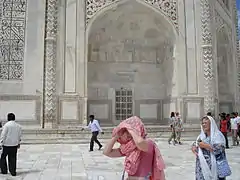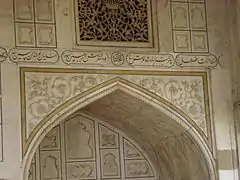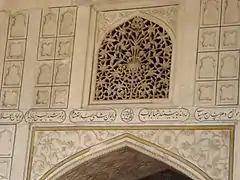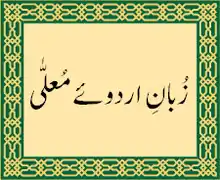تأثیرات زبان فارسی بر زبان اردو
زبان فارسی در شکلگیری بسیاری از زبانهای نوین بزرگ خاورمیانه، آسیای مرکزی، جنوبی و مناطق آسیایی، از جمله اردو تأثیر فراوان داشتهاست.[1] پس از فتح محمود غزنوی، یک زبان ترکیبی بر پایه هندی و وام واژههای از زبانهای ترکی، فارسی، عربی و محلی در آسیای غربی ایجاد گردید که در نهایت به عنوان زبان اردو شناخته شد. این زبان به خط نست فارسی نوشته شده و با زبان هندی نیز تا حدوی شباهت دارد. اردو ایرانی شده- اسلامی سازی زبان هندوستانی است. اردو گویشی از این زبان است که در پاکستان به کار میرود، با خط فارسی - عربی نوشته میشود و مملو از واژگان تخصصی و ادبی فارسی و واژگان عربی (راه یافته از طریق زبان فارسی) است. اما هندی گویشی است که در هندوستان به کار میرود و با خط دیواناگری نوشته میشود و در انتخاب واژگان تخصصی و ادبی بر زبان سانسکریت تکیه میکند. زبان واحد هندوستانی از لحاظ مجموع گویشوران چهارمین زبان جهان است. اردو زبان مادری کمتر از هشت درصد مردم پاکستان است، اما نزدیک به نود درصد مردم این کشور اردو را بلدند و میتوانند به این زبان صحبت کنند. لازم است ذکر شود که برخی از مردم افغانستان هم به این زبان صحبت میکنند. این زبان به نام اردو یعنی زبان ارتش نامیده شد، زیرا زبانی بود که در دربار در بین نظامیان رایج بود. زبان اردو آنقدر به فارسی نزدیک است که سرود ملی پاکستان و بسیاری از اشعار اردو به صورت کامل برای فارسی زبانان قابل فهم است.







زبان اردو بیش از نیمی از واژگان (بهطور مستقیم یا غیرمستقیم) و بخش عمده دستور زبان و الفبا و شعر خود را از زبان پارسی گرفتهاست. امروزه زبانهای فارسی و اردو از جمله نزدیکترین زبانهای جهان به یکدیگر بهشمار میروند. زبان اردو چون در محیط زبان فارسی بالیده و رشد کردهاست، به شدت تحت تأثیر این زبان قرار گرفتهاست. این تأثیر به ویژه در ادبیات اردو تا آن حد است که شعر اردو را پرتویی از شعر فارسی شمردهاند. ادبیات اردو در زیر بال شعر فارسی پرورش یافته، از این مادرخوانده نظم و نثر، سبک و مضمون، بحر و وزن و قافیه و شکل را به ارث برده و مخصوصاً الفاظش بهطور کامل از فارسی نشات گرفتهاست.[2]
با وجود نفوذ سنگین زبان فارسی در زبان اردو، زبان اردو به عنوان یک زبان هندی زیر شاخه زبانهای هندو-ایرانی طبقهبندی شدهاست. زبان اردو به زودی تمایز در حوزههای فرهنگی و ادبی به دلیل ماهیت ترکیبی از زبان به دست آورد. بسیاری از اشکال و مجزا فارسی از ادبیات، از جمله غزل، قصیده، مرثیه و نظم، به ادبیات اردو رسید، با تولید مجزا ایران و جنوب آسیا میراث. نویسنده معروف متقاطع، امیر خسرو، که فارسی و اردو به این روز خواندن در آسیای جنوبی و مرکزی بود.
تاریخچه
زبان فارسی و معماری دو نماد اصلی فرهنگ هندو ایرانی در درجه بعد عرفان و مذهب اسلام آمیخته از تساهل و تسامح در دوره گورکانیان است. برای هفتصد سال فارسی زبان اداری و دربار هندوستان بود تا اینکه در سال ۱۸۳۶ میلادی چارلز تری ویلیان زبان انگلیسی را به جای زبان فارسی رسمیت داد.[3]
نفوذ فارسی برای اولین بار توسط حاکمان مسلمان به شبه قاره یعنی امپراتوری گورکانی طی قرنهای ۱۳ تا ۱۹ میلادی بود. با این حال، آثار پراکنده از نفوذ فارسی پیش از اسلام در شبه قاره وجود دارد.[3] تاریخ پیوند ایران و هند به هزاران سال پیش برمیگردد. تاریخنگاران مینویسند که وقتی حدود ۱۱۰۰ تا ۱۵۰۰ سال پیش از میلاد، تیرههای آریایی از درهٔ خیبر وارد سرزمینهای ایران و هند شدند، روابط فرهنگی و زبانیِ این دو کشور از آن روزگار آغاز گردید.
همانندیهای فراوان میان زبان اوستا و سانسکریت هم نشانه دیگری از پیوند دیرینه ایران و شبه قاره دارد. در دوران اشکانیان (۲۲۶–۲۴۹ ق. م) این روابط رو به گسترش نهاد تا این که در زمان ساسانیان (۲۲۶ ق. م - ۶۵۲ م) با وجود ترجمه کتابهای مهم هندی مانند «کلیله و دمنه» در عصر انوشیروان، پیوستگیهای فرهنگی قوت گرفت.[4]
با حضور فرهنگ اسلامی در این منطقه در دوره غزنویان، لاهور و یوچه به عنوان مراکز ادبیات فارسی تأسیس شد. ابو فرج رونی و غمگین مسعود سلمان (متوفی ۱۱۲۱)، دو اولین عمده شاعران هند و فارس در لاهور بود. اولین «بزرگ» هند و فارسی شاعران امیر خسرو (متوفی ۱۳۲۵) از دهلی نو، که از آنجا که حضور نمادین در شبه قاره، در میان چیزهای دیگر، «پدر» ادبیات اردو به دست آمده بود.[5][6]
واژگان اردو
در برخی متون تا ۷۰ درصد واژگان زبان اردو، فارسی است. سید احمد دهلوی میزان آن را حدود ۳۰ درصد میداند. همیرا شهباز استادیار یکی از دانشگاههای پاکستان اعتقاد دارد ۶۰ درصد کلمات زبان اردو برگرفته از زبان فارسی است. زمانی بیش از هشتاد یا نود درصد کلمات تشکیل دهنده زبان اردو واژگان فارسی یا عربی بودهاست. ورود واژگان و عبارات انگلیسی و زبانهای بومی به زبان اردو این نسبتها را برهم زده و در فرهنگ لغت اردوی «فیروزاللغات» واژهها و ترکیبهای فارسی بیش از بیستوپنج درصد نیست. بررسی زبان اردو نشان میدهد که تأثیر زبان فارسی بر اردو اگرچه برای گسترش دامنهٔ ادبیات در این زبان بوده ولی این اثرپذیری دایرهٔ گستردهای داشته و شامل اسامی، افعال، حروف، محاورات، تشبیهات، استعارهها، ترکیبها و ضربالمثلها میشود. مشترکات فارسی و اردو بسیار زیاد است و زبان فارسی نه تنها بر اردو بلکه بر دیگر زبانهای پاکستان نیز اثرات عمیق بر جای گذاشتهاست. نخستین زبانی که در شبه قاره و پاکستان از فارسی بسیار متأثر گردید، زبان پنجابی بود. زبان پنجابی بدون واسطه با زبان فارسی ارتباط برقرار کرد و از آمیزش آنها چنان خمیرمایهای آماده کرد که چون به دهلی رسید زبان اردو به وجود آمد.[7][8] طبق تخمین دیگر ۶۰ درصد واژگان زبان اردو از فارسی گرفته شدهاست.[9]
سید احمد دهلوی، یک فرهنگنویس از قرن ۱۹ که فرهنگ اشرفیه اردو را نوشتهاست، برآورد کردهاست که ۷۵ درصد از واژگان[10][11][12] و در حدود ۹۹٪ از فعلهای اردو ریشه در سانسکریت و پراکریت دارند.[13][14] حدود ۲۵٪[15][16][17][18] تا ۳۰٪[19]از واژگان اردو از فارسی و به میزان کمتری عربی از طریق فارسی،[20] وام گرفته شدهاند. افروز تاج، زبانشناس دانشگاه کارولینای شمالی در چپل هیل، در آماری نسبت وامواژگان فارسی به واژگان بومی سانسکریت در اردوی ادبی ۱ به ۳ برآورد کردهاست.[21] طبق برآوردی دیگر ۶۰٪ از واژگان زبان اردو از فارسی گرفته شدهاست.[22]

«گرایش به فارسیسازی» اردو از قرن هجدهم توسط مکتب شاعران اردو در دهلی آغاز شد، گرچه نویسندگان دیگری مانند معراجی به گونه سانسکریتشده این زبان مینوشتند.[24]از سال ۱۹۴۷ در پاکستان حرکت به سمت فارسیسازی بیش از حد اردو صورت گرفتهاست که توسط بسیاری از نویسندگان این کشور پذیرفته شدهاست.[25]به همین ترتیب، برخی از متون اردو میتوانند از ۷۰٪ واژه وام فارسی-عربی تشکیل شوند.[26] برخی از اردوزبانان پاکستانی به دلیل قرار گرفتن در معرض رسانههای هندی، واژگان هندی را در گفتار خود گنجاندهاند.[27][28]در هند، اردو به اندازه پاکستان از هندی جدا نشدهاست.[29]
بیشتر وامواژگان اردو اسم و صفت هستند.[30]بسیاری از واژگان عربی اردو از طریق فارسی وارد آن شدهاند،[31]و گاه تلفظ، کاربرد و معنای آنها متفاوت از عربی است. در اردو همچنین وامواژگان کمی از پرتغالی یافت میشوند. چند نمونه از این واژگان عبارتند از: از کابی ("chave": کلید)، گیرجا ("igreja": کلیسا)، کامرا ("cámara": اتاق)، قمیز ("camisa": پیراهن)، مز ("mesa": جدول).[32]
اگر چه نام اردو از واژه ترکی اردو (ارتش) یا اردا آمده که از آن واژه انگلیسی horde (گروه ترکان و مغولان) نیز مشتق شدهاست،[33]اردو دارای وامواژگان بسیار کمی از ترکی است[34]و از نظر ژنتیکی نیز به زبانهای ترکی ارتباطی ندارد. بیشتر واژگان اردو که از جغتایی و عربی ریشه گرفتهاند، در اصل از راه فارسی آمدهاند و از این رو نسخه فارسیشده واژگان اصلی هستند. به عنوان مثال، تاء مربوطه (ة) عربی در اردو همانند فارسی به ه (ه) یا ت (ت) تغییر پیدا میکند.[35] اندک وامواژگان ترکی موجود در اردو از زبان جغتایی، یک زبان ترکی از آسیای میانه، آمدهاند. اردو و ترکی هر دو از عربی و فارسی وام بسیار گرفتهاند، از این رو بسیاری از واژههای آن دو در تلفظ شباهت دارند.[36]
اردو ایرانی شده- اسلامی سازی زبان هندوستانی است. اردو گویشی از این زبان است که در پاکستان به کار میرود، با خط فارسی نوشته میشود و مملو از واژگان تخصصی و ادبی فارسی و واژگان عربی (راه یافته از طریق زبان فارسی) است. اما هندی گویشی است که در هندوستان به کار میرود و با خط دیواناگری نوشته میشود و در انتخاب واژگان تخصصی و ادبی بر زبان سانسکریت تکیه میکند. زبان واحد هندوستانی از لحاظ مجموع گویشوران چهارمین زبان جهان است. اردو زبان مادری کمتر از هشت درصد مردم پاکستان است، اما نزدیک به نود درصد مردم این کشور اردو را بلدند و میتوانند به این زبان صحبت کنند. لازم است ذکر شود که برخی از مردم افغانستان هم به این زبان صحبت میکنند.
شعر اردو
شعر اردو که به شدت از ادبیات فارسی تأثیر گرفته یکی از گونههای غنی ادبیات در پاکستان و شمال هند است. بخش عمدهای از بزرگان این زبان از شیعیان و مرثیه سرایان عاشورا بودهاند. در مقایسه با شعر فارسی، قدمت شعر اردو زیاد نیست. با اینکه شعر اردو همه داروندار اولیهاش از شعر فارسی مستعار بوده است، با گذرِ زمان فاصلههای قابلِ ملاحظهای بین شعر اردو و فارسی ایجاد شده است و امروز بسیاری از نکاتی که در شعرِ اردو موردِ قبول واقع شدهاند، به صورت اعمال در شعرِ فارسی اشکال محسوب میگردند و برعکس. مانند غزلهای فارسی سبک هندی، غزل اردو هم غزل بیتمحور است و هر بیتش به تنهایی معنای جداگانهای را به مخاطب ارائه میدهد و قابلیت این را دارد که به طور مجزا در هر کجا استفاده شود. هرچند شعر کلاسیک فارسی هم همینطور بوده است. اما امروز در ایران بیشتر غزلها منسجم بوده و انسجام عمودی دارند. حتی غزلهایی که موضوعاتِ مختلفی در آنها گنجانیده شدهاند و در نگاه اول غزل بیتمحور به نظر میآیند، یک انسجام کلی موضوعی در خود دارند. [37]
جستارهای وابسته
- فرهنگ هندوایرانی
- ایرانیان در امپراتوری گورکانی
- اسلام در هند
- فهرست ایالتها و سرزمینهای ملی هند بر پایه جمعیت
- فهرست رئیسجمهورهای هند
- اقتصاد هند
- سازمان همکاری شانگهای
- ادب پارسی در هند
- سرایندگان ایرانی در شبهقاره هند
- زبان فارسی در پاکستان
- فهرست شهرهای هند
- روابط ایران و هندوستان
- زبان فارسی در کشمیر
- احزاب سیاسی در هند
- زبان فارسی در شبهقاره هندوستان
- فرهنگهای واژگان زبان فارسی
پانویس
- Ethnologue report for Iranian
- https://www.sid.ir/fa/journal/ViewPaper.aspx?id=106606
- پژوهشی در تأثیر زبان فارسی بر زبانهای شبه قاره هندوستان ایرنا
- تأثیر زبان فارسی بر زبان و ادبیات شبه قاره هند بایگانیشده در ۸ اکتبر ۲۰۱۸ توسط Wayback Machine حوزه هنری دکتر عجم
- "INDIA xvi. INDO-PERSIAN HISTORIOGRAPHY".
- http://www.iranicaonline.org/articles/ghurids Iranica: GHURIDS or Āl-e Šansab; a medieval Islamic dynasty of the eastern Iranian lands.
- http://atraknews.com/new.aspx?id=28151
- https://www.tasnimnews.com/fa/news/1392/04/27/99817/زبان-فارسی-در-پاکستان-هرجا-می-رویم-زودتر-از-ما-زبان-فارسی-رفته-است
- http://www.iranchamber.com/literature/articles/language_of_armies.php
- Ahmad, Aijaz (2002). Lineages of the Present: Ideology and Politics in Contemporary South Asia. Verso. p. 113. ISBN 978-1-85984-358-1.
On this there are far more reliable statistics than those on population. Farhang-e-Asafiya is by general agreement the most reliable Urdu dictionary. It was compiled in the late nineteenth century by an Indian scholar little exposed to British or Orientalist scholarship. The lexicographer in question, Syed Ahmed Dehlavi, had no desire to sunder Urdu's relationship with Farsi, as is evident even from the title of his dictionary. He estimates that roughly 75 per cent of the total stock of 55,000 Urdu words that he compiled in his dictionary are derived from Sanskrit and Prakrit, and that the entire stock of the base words of the language, without exception, are derived from these sources. What distinguishes Urdu from a great many other Indian languauges … is that it draws almost a quarter of its vocabulary from language communities to the west of India, such as Farsi, Turkish, and Tajik. Most of the little it takes from Arabic has not come directly but through Farsi.
- Dalmia, Vasudha (31 July 2017). Hindu Pasts: Women, Religion, Histories. SUNY Press. p. 310. ISBN 978-1-4384-6807-5.
On the issue of vocabulary, Ahmad goes on to cite Syed Ahmad Dehlavi as he set about to compile the Farhang-e-Asafiya, an Urdu dictionary, in the late nineteenth century. Syed Ahmad 'had no desire to sunder Urdu's relationship with Farsi, as is evident from the title of his dictionary. He estimates that roughly 75 percent of the total stock of 55.000 Urdu words that he compiled in his dictionary are derived from Sanskrit and Prakrit, and that the entire stock of the base words of the language, without exception, are from these sources' (2000: 112–13). As Ahmad points out, Syed Ahmad, as a member of Delhi's aristocratic elite, had a clear bias towards Persian and Arabic. His estimate of the percentage of Prakitic words in Urdu should therefore be considered more conservative than not. The actual proportion of Prakitic words in everyday language would clearly be much higher.
- Taj, Afroz (1997). "About Hindi-Urdu". University of North Carolina at Chapel Hill. Archived from the original on 15 August 2009. Retrieved 27 March 2018.
- "Urdu's origin: it's not a "camp language"". dawn.com. 17 December 2011. Archived from the original on 24 September 2015. Retrieved 5 July 2015.
Urdu nouns and adjective can have a variety of origins, such as Arabic, Persian, Turkish, Pushtu and even Portuguese, but ninety-nine per cent of Urdu verbs have their roots in Sanskrit/Prakrit. So it is an Indo-Aryan language which is a branch of Indo-Iranian family, which in turn is a branch of Indo-European family of languages. According to Dr Gian Chand Jain, Indo-Aryan languages had three phases of evolution beginning around 1,500 BC and passing through the stages of Vedic Sanskrit, classical Sanskrit and Pali. They developed into Prakrit and Apbhransh, which served as the basis for the formation of later local dialects.
- "Urdu's origin: it's not a "camp language"". dawn.com. 17 December 2011. Archived from the original on 24 September 2015. Retrieved 5 July 2015.
Urdu nouns and adjective can have a variety of origins, such as Arabic, Persian, Turkish, Pushtu and even Portuguese, but ninety-nine per cent of Urdu verbs have their roots in Sanskrit/Prakrit. So it is an Indo-Aryan language which is a branch of Indo-Iranian family, which in turn is a branch of Indo-European family of languages. According to Dr Gian Chand Jain, Indo-Aryan languages had three phases of evolution beginning around 1,500 BC and passing through the stages of Vedic Sanskrit, classical Sanskrit and Pali. They developed into Prakrit and Apbhransh, which served as the basis for the formation of later local dialects.
- Ahmad, Aijaz (2002). Lineages of the Present: Ideology and Politics in Contemporary South Asia. Verso. p. 113. ISBN 978-1-85984-358-1.
On this there are far more reliable statistics than those on population. Farhang-e-Asafiya is by general agreement the most reliable Urdu dictionary. It was compiled in the late nineteenth century by an Indian scholar little exposed to British or Orientalist scholarship. The lexicographer in question, Syed Ahmed Dehlavi, had no desire to sunder Urdu's relationship with Farsi, as is evident even from the title of his dictionary. He estimates that roughly 75 per cent of the total stock of 55,000 Urdu words that he compiled in his dictionary are derived from Sanskrit and Prakrit, and that the entire stock of the base words of the language, without exception, are derived from these sources. What distinguishes Urdu from a great many other Indian languauges … is that it draws almost a quarter of its vocabulary from language communities to the west of India, such as Farsi, Turkish, and Tajik. Most of the little it takes from Arabic has not come directly but through Farsi.
- Dalmia, Vasudha (31 July 2017). Hindu Pasts: Women, Religion, Histories. SUNY Press. p. 310. ISBN 978-1-4384-6807-5.
On the issue of vocabulary, Ahmad goes on to cite Syed Ahmad Dehlavi as he set about to compile the Farhang-e-Asafiya, an Urdu dictionary, in the late nineteenth century. Syed Ahmad 'had no desire to sunder Urdu's relationship with Farsi, as is evident from the title of his dictionary. He estimates that roughly 75 percent of the total stock of 55.000 Urdu words that he compiled in his dictionary are derived from Sanskrit and Prakrit, and that the entire stock of the base words of the language, without exception, are from these sources' (2000: 112–13). As Ahmad points out, Syed Ahmad, as a member of Delhi's aristocratic elite, had a clear bias towards Persian and Arabic. His estimate of the percentage of Prakitic words in Urdu should therefore be considered more conservative than not. The actual proportion of Prakitic words in everyday language would clearly be much higher.
- Taj, Afroz (1997). "About Hindi-Urdu". University of North Carolina at Chapel Hill. Archived from the original on 15 August 2009. Retrieved 27 March 2018.
- Khan, Iqtidar Husain (1989). Studies in Contrastive Analysis. The Department of Linguistics of Aligarh Muslim University. p. 5.
It is estimated that almost 25% of the Urdu vocabulary consists of words which are of Persian and Arabic origin.
- American Universities Field Staff (1966). Reports Service: South Asia series. American Universities Field Staff. p. 43.
The Urdu vocabulary is about 30% Persian.
- Versteegh, Kees; Versteegh, C. H. M. (1997). The Arabic Language. Columbia University Press. ISBN 978-0-231-11152-2.
... of the Qufdn; many Arabic loanwords in the indigenous languages, as in Urdu and Indonesian, were introduced mainly through the medium of Persian.
- Taj, Afroz (1997). "About Hindi-Urdu". University of North Carolina at Chapel Hill. Archived from the original on 15 August 2009. Retrieved 27 March 2018.
- http://www.iranchamber.com/literature/articles/language_of_armies.php
- Ahmad, Rizwan (2011). "Urdu in Devanagari: Shifting orthographic practices and Muslim identity in Delhi". Language in Society. Cambridge University Press. 40 (3): 259–284. doi:10.1017/S0047404511000182. hdl:10576/10736. JSTOR 23011824.
- Das, Sisir Kumar (2005). History of Indian Literature: 1911–1956, struggle for freedom: triumph and tragedy. Sahitya Akademi. ISBN 9788172017989.
Professor Gopi Chand Narang points out that the trends towards Persianization in Urdu is not a new phenomenon. It started with the Delhi school of poets in the eighteenth century in the name of standardization (meyar-bandi). It further tilted towards Arabo-Persian influences, writes Narang, with the rise of Iqbal. 'The diction of Faiz Ahmad Faiz who came into prominence after the death of Iqbal is also marked by Persianization; so it is the diction of N.M. Rashid, who popularised free verse in Urdu poetry. Rashid's language is clearly marked by fresh Iranian influences as compared to another trend-setter, Meeraji. Meeraji is on the other extreme because he used Hindized Urdu.'
- Shackle, C. (1 January 1990). Hindi and Urdu Since 1800: A Common Reader. Heritage Publishers. ISBN 9788170261629.
- Kaye, Alan S. (30 June 1997). Phonologies of Asia and Africa: (including the Caucasus). Eisenbrauns. ISBN 978-1-57506-019-4.
- Patel, Aakar (6 January 2013). "Kids have it right: boundaries of Urdu and Hindi are blurred". Firstpost. Retrieved 9 November 2019.
- Gangan, Surendra (30 November 2011). "In Pakistan, Hindi flows smoothly into Urdu". DNA India. Retrieved 9 November 2019.
That Bollywood and Hindi television daily soaps are a hit in Pakistan is no news. So, it's hardly surprising that the Urdu-speaking population picks up and uses Hindi, even the tapori lingo, in its everyday interaction. "The trend became popular a few years ago after Hindi films were officially allowed to be released in Pakistan," said Rafia Taj, head of the mass communication department, University of Karachi. "I don't think it's a threat to our language, as it is bound to happen in the globalisation era. It is anytime better than the attack of western slangs on our language," she added.
- Clyne, Michael (24 May 2012). Pluricentric Languages: Differing Norms in Different Nations. Walter de Gruyter. ISBN 978-3-11-088814-0.
- Jain, Danesh; Cardona, George (26 July 2007). The Indo-Aryan Languages. Routledge. p. 294. ISBN 978-1-135-79711-9.
- Ahmad, Aijaz (2002). Lineages of the Present: Ideology and Politics in Contemporary South Asia. Verso. p. 113. ISBN 978-1-85984-358-1.
On this there are far more reliable statistics than those on population. Farhang-e-Asafiya is by general agreement the most reliable Urdu dictionary. It was compiled in the late nineteenth century by an Indian scholar little exposed to British or Orientalist scholarship. The lexicographer in question, Syed Ahmed Dehlavi, had no desire to sunder Urdu's relationship with Farsi, as is evident even from the title of his dictionary. He estimates that roughly 75 per cent of the total stock of 55,000 Urdu words that he compiled in his dictionary are derived from Sanskrit and Prakrit, and that the entire stock of the base words of the language, without exception, are derived from these sources. What distinguishes Urdu from a great many other Indian languauges … is that it draws almost a quarter of its vocabulary from language communities to the west of India, such as Farsi, Turkish, and Tajik. Most of the little it takes from Arabic has not come directly but through Farsi.
- Paul Teyssier: História da Língua Portuguesa, S. 94.
- Peter Austin (1 September 2008). One thousand languages: living, endangered, and lost. University of California Press. pp. 120–. ISBN 978-0-520-25560-9. Archived from the original on 9 May 2013. Retrieved 29 December 2011.
- InpaperMagazine (13 November 2011). "Language: Urdu and the borrowed words". dawn.com. Archived from the original on 2 July 2015. Retrieved 29 March 2015.
- John R. Perry, "Lexical Areas and Semantic Fields of Arabic" in Éva Ágnes Csató, Eva Agnes Csato, Bo Isaksson, Carina Jahani, Linguistic convergence and areal diffusion: case studies from Iranian, Semitic and Turkic, Routledge, 2005. pg 97: "It is generally understood that the bulk of the Arabic vocabulary in the central, contiguous Iranian, Turkic and Indic languages was originally borrowed into literary Persian between the ninth and thirteenth centuries"
- María Isabel Maldonado García; Mustafa Yapici (2014). "Common Vocabulary in Urdu and Turkish Language: A Case of Historical Onomasiology" (PDF). Journal of Pakistan Vision. 15 (1): 193–122. Archived from the original (PDF) on 27 September 2015.
- https://farhangeeslami.com/هنر/شعر-در-دو-زبان-فارسی-و-اردو/
بیشتر
- Multiple authors (2004). "India". [[دانشنامه ایرانیکا|Encyclopædia Iranica]]. URL–wikilink conflict (help) (series of entries that cover Indian history and its relations with Iran)
- Cole, Juan R.I. "Iranian Culture and South Asia، 1500-1900". in: Keddie, Nikki; Matthee, Rudolph P. (ed.). (2002). Iran and the Surrounding World: Interactions in Culture and Cultural Politics. University of Washington Press. ISBN 0-295-98206-3. pp. 15–35.
- Kirmani, Waris. Dreams Forgotten: An Anthology of Indo-Persian Poetry. (Aligarh، ۱۹۸۴)
- Nabi Hadi. Dictionary of Indo-Persian Literature. (New Delhi، ۱۹۹۵)
- Chopra, R.M. Indo-Iranian Cultural Relations Through The Ages. Iran Society, 2005.